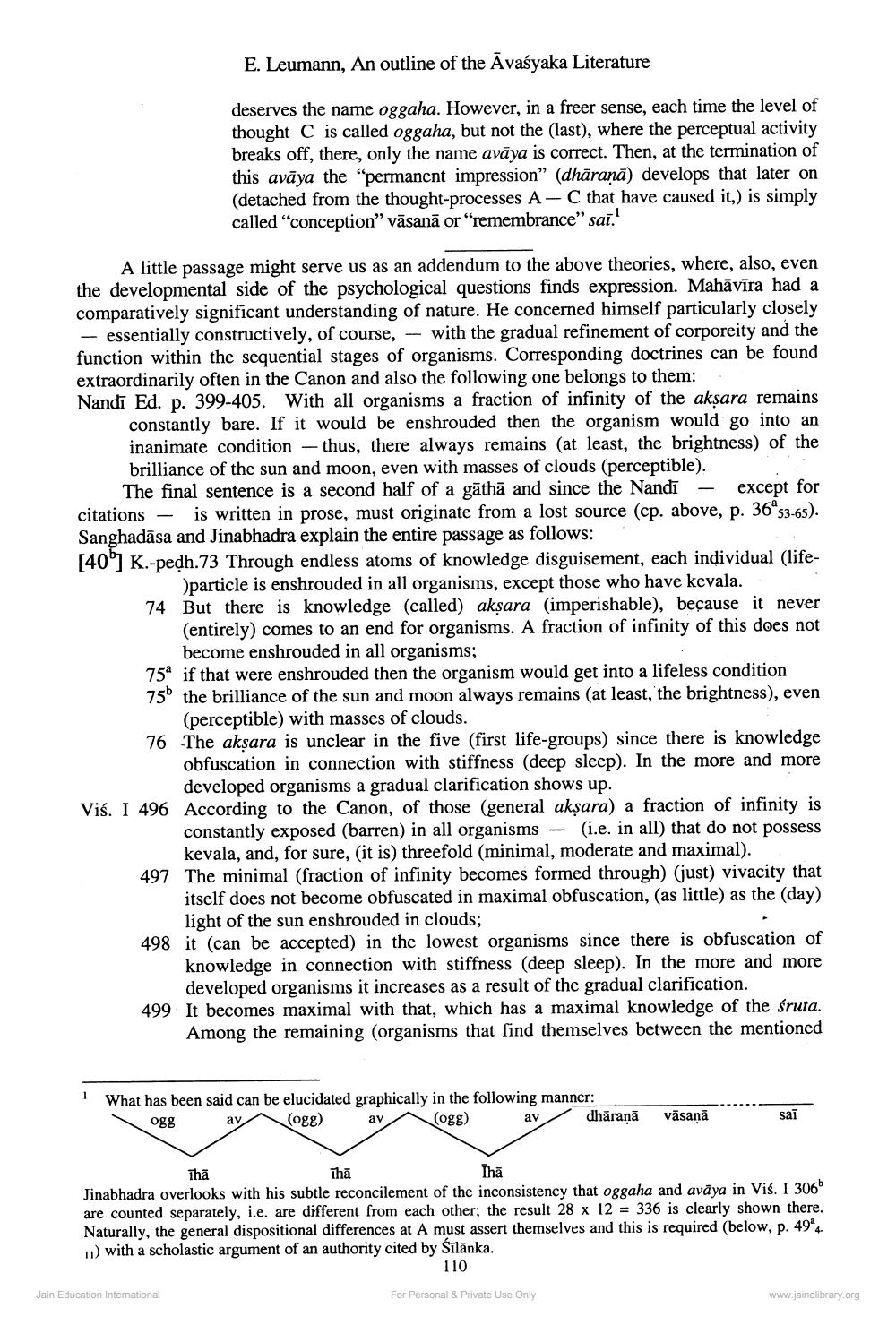________________
E. Leumann, An outline of the Āvaśyaka Literature
deserves the name oggaha. However, in a freer sense, each time the level of thought C is called oggaha, but not the (last), where the perceptual activity breaks off, there, only the name avāya is correct. Then, at the termination of this avāya the "permanent impression” (dhāraṇā) develops that later on (detached from the thought-processes A-C that have caused it,) is simply called "conception" vāsanā or "remembrance” sai.'
A little passage might serve us as an addendum to the above theories, where, also, even the developmental side of the psychological questions finds expression. Mahāvīra had a comparatively significant understanding of nature. He concerned himself particularly closely
- essentially constructively, of course, - with the gradual refinement of corporeity and the function within the sequential stages of organisms. Corresponding doctrines can be found extraordinarily often in the Canon and also the following one belongs to them: Nandi Ed. p. 399-405. With all organisms a fraction of infinity of the aksara remains
constantly bare. If it would be enshrouded then the organism would go into an inanimate condition - thus, there always remains (at least, the brightness) of the brilliance of the sun and moon, even with masses of clouds (perceptible).
The final sentence is a second half of a gāthā and since the Nandi - except for citations – is written in prose, must originate from a lost source (cp. above, p. 36°53-65). Sanghadāsa and Jinabhadra explain the entire passage as follows: [40'] K.-pedh.73 Through endless atoms of knowledge disguisement, each individual (life
particle is enshrouded in all organisms, except those who have kevala. 74 But there is knowledge (called) aksara (imperishable), because it never
(entirely) comes to an end for organisms. A fraction of infinity of this does not
become enshrouded in all organisms; 759 if that were enshrouded then the organism would get into a lifeless condition 750 the brilliance of the sun and moon always remains (at least, the brightness), even
(perceptible) with masses of clouds. 76 The aksara is unclear in the five (first life-groups) since there is knowledge
obfuscation in connection with stiffness (deep sleep). In the more and more
developed organisms a gradual clarification shows up. Viś. I 496 According to the Canon, of those (general aksara) a fraction of infinity is
constantly exposed (barren) in all organisms — (i.e. in all) that do not possess
kevala, and, for sure, (it is) threefold (minimal, moderate and maximal). 497 The minimal (fraction of infinity becomes formed through) (just) vivacity that
itself does not become obfuscated in maximal obfuscation, (as little) as the (day)
light of the sun enshrouded in clouds; 498 it can be accepted) in the lowest organisms since there is obfuscation of
knowledge in connection with stiffness (deep sleep). In the more and more
developed organisms it increases as a result of the gradual clarification. 499 It becomes maximal with that, which has a maximal knowledge of the śruta.
Among the remaining (organisms that find themselves between the mentioned
What has been said can be elucidated graphically in the following manner: av
av
logg) av dhāraṇā
ogg
(ogg)
vāsanā
Thā īhā
Ihā Jinabhadra overlooks with his subtle reconcilement of the inconsistency that oggaha and avāya in Vis. I 306 are counted separately, i.e. are different from each other; the result 28 x 12 = 336 is clearly shown there. Naturally, the general dispositional differences at A must assert themselves and this is required (below, p. 4994 11) with a scholastic argument of an authority cited by Sīlānka.
110
Jain Education International
For Personal & Private Use Only
www.jainelibrary.org




